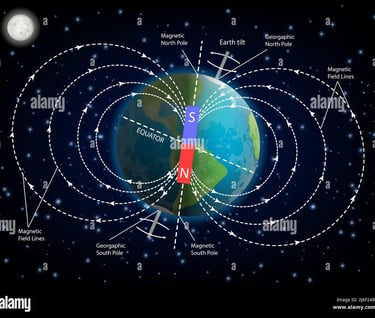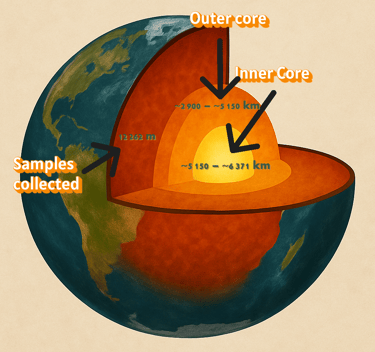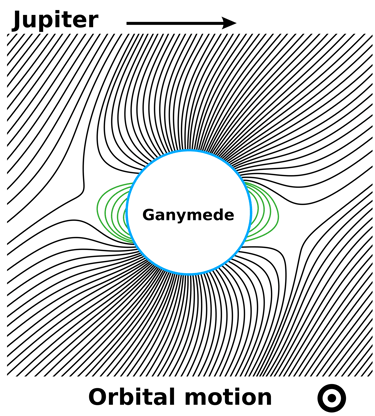Something Doesn’t Add Up: Planetary Magnetic Fields in Light of the Facts
7/27/20259 min read


Today’s models of planetary magnetic fields fail to explain many observed anomalies – from Jupiter’s massive disturbances to Ganymede’s mysterious field. Find out what might be behind this and why mainstream science still has no good answer.
Do we really know where planetary magnetic fields come from?
From the Kola Borehole to Ganymede – science versus observation
Official Scientific Explanations of the Origin of Planetary Magnetic Fields
Genesis of the Idea – Planetary Dynamo
The model explaining the formation of planetary magnetic fields was proposed in the early 20th century. As early as 1919, Joseph Larmor suggested that the Sun's magnetic field could be sustained by a hydromagnetic mechanism (later called a dynamo). The model for planets developed in the 1950s–60s thanks to the work of Walter Elsasser, who combined rotation, convection, and conductivity into a coherent theory of the planetary dynamo.
According to this theory, the magnetic field arises from:
A conductive liquid core (an iron-nickel alloy in rocky planets or metallic hydrogen in gas giants),
Thermal convection, i.e., the upward movement of warmer material and downward movement of cooler material,
Planetary rotation, which, through the Coriolis effect, organizes movements into large vortices.
This generates electric currents which, by Ampère's law and Faraday's induction, sustain their own magnetic field in a system called a dynamo.
Examples from the Solar System
Planets and Moons with a Distinct Magnetic Field:
Earth: a classic example of an active dynamo, with a liquid iron-nickel core and 24-hour rotation. Average field ~30 μT.
Jupiter: the largest field in the Solar System (~4 gauss at the equator), thanks to a dynamo in the metallic hydrogen layer.
Saturn: also a strong field, almost perfectly aligned with the rotation axis.
Uranus: strong field, but highly tilted relative to the rotation axis and offset from the planet's center, indicating a different dynamic source than the classical dynamo.
Neptune: like Uranus, the field is offset and tilted, irregular, possibly due to a conductive layer located higher than the core.
Ganymede: the only known moon with a permanent global magnetic field, likely from a liquid iron core.
Objects Without a Distinct Field:
Mercury: has a very weak field (~1% of Earth's), possibly due to inefficient convection.
Venus: practically no magnetic field, due to extremely slow rotation (243 days).
Mars: currently without a global field, but the crust contains strongly magnetized areas (a remnant of a former dynamo).
Moon: only local magnetization in the crust, no active field.
Modern Conclusion
Science summarizes it like this: three things are needed for a magnetic field to exist – a conductive, sufficiently large core, a significant temperature gradient (to drive convection), and rapid rotation (to organize global-scale movement). The lack of any of these elements means a very weak or absent field.
Joseph Larmor (1919): Foundations of the Dynamo Hypothesis. Wikipedia
Joseph Larmor proposed that if a conducting fluid moves in a magnetic field, it can generate current, which sustains the magnetic field. This was a theoretical analogy to the operation of Faraday's disk — a simple model of a rotating conductor in a magnetic field.
Since there were no available observations of the interior of the Sun or Earth, the theory relied solely on physical analogies and the analysis of electromagnetic and hydrodynamic equations. Even then, the concept assumed the existence of a conducting medium and its dynamic behavior.
Walter M. Elsasser (1950s–60s): Consolidation and Empirical Foundations
Elsasser introduced empirical support into the theory. He used several key observations:
Paleomagnetism – analysis of the orientation of minerals in solidified rocks (basalts, lavas) showed that Earth changed the polarity of its magnetic field many times. This suggests the field does not come from a permanent magnet but is variable and renewable.
Field reversal analysis – reversals occur every ~0.2–1 million years, consistent with an unstable, dynamic mechanism.
Structure of the geomagnetic field – dominance of the dipole, presence of higher-order components (spherical harmonics), time variability – all this suggests an active source deep within the planet.
Magnetohydrodynamic (MHD) simulations – computer models replicating conditions in Earth's core generate fields with similar structure, strength, variability, and reversals.
What Observations and Data Supported the Theory?
Geological Paleomagnetism
Studies of solidified rocks (e.g., basalts) usually found at depths of 0–5 km below the surface. These rocks are measured for the direction and intensity of residual magnetization, allowing reconstruction of the history of Earth's magnetic field.
Structure of the Geomagnetic Field
Measurements indicate dominance of the dipolar component and temporal variability. These are data from Earth's surface or satellites, not from the interior.
Numerical Simulations
Computer models based on fluid physics, electromagnetism, and convection show that a similar field could arise in a rotating, conductive liquid.
What Do We Actually Observe, and What Do We Only Model?
Element Direct observation? Data source
Magnetic field at the surface ✅ Yes magnetometer measurements
Changes in the field over time ✅ Yes geological and satellite data
Movements in the core ❌ No pure mathematical simulation
Temperature and dynamics of the core ❌ No thermal models + seismic data
Dynamo simulations ❌ No (just a model) mathematics + supercomputers
Location of the Field Source vs. Observation Site
Earth's outer core (liquid): 2,900–5,100 km below the surface.
Inner core (solid): 5,100–6,371 km.
Layers where paleomagnetic data is recorded: 0–5 km.
➡️ The difference between the source and the recorded effect is up to 6,000 km.
Is the Theory Based Solely on Mathematics and Simulations?
✅ Yes. The entire planetary dynamo theory is based on:
Navier-Stokes equations (hydrodynamics),
Maxwell's equations (electromagnetism),
equations of convection and thermal gradients,
numerical processing (MHD simulations).
There are no direct data from Earth's interior confirming convection in the core. Everything is based on deduction.
Conclusions
The planetary dynamo model was developed to explain the variability and strength of the magnetic field. Although it explains certain phenomena well, it is almost entirely based on indirect data and computer simulations. It is a highly developed mathematical model, but not the result of direct observation of the interiors of planets.
Critical View of the Dynamo Model
Let’s take a closer look at the dynamo issue — it is a very logical and reasonable assumption, but is it really the case that this phenomenon occurs between the inner and outer cores?
As mentioned above, the samples used to confirm this phenomenon come from much shallower regions than the core. Another issue that complicates this model even more is the assumption that planets without a magnetosphere should be treated as having an inactive core. Logically and sensibly speaking — if all celestial bodies formed in a similar way, their interiors should be fundamentally the same.
A perfect example of this is the drill hole in Russia – the so-called Kola Superdeep Borehole (SG-3). It began in 1970 and was completed in 1989. It reached a depth of 12,262 meters, which is only about 0.2% of Earth’s radius. In this borehole:
the temperature reached as high as ~180°C, much more than expected,
a steady, nonlinear temperature increase with depth was observed,
an increase in pressure and radiation was also noted.
A second piece of evidence is the Galileo mission, whose probe entered Jupiter’s atmosphere on December 7, 1995. During its descent, instead of encountering expected storms and high humidity, it fell into the so-called "Hot Spot" – a dry and calm region. Instead of expected convection:
very low water content was detected (~0.4% instead of the predicted 3–5%),
no storms or strong convective movements were observed,
temperature and pressure steadily increased as the probe descended – until it was destroyed at a temperature of about 150°C and pressure over 22 bar.
Namely — both of these studies clearly showed that temperature increases with depth and pressure. It’s hard to imagine that somewhere deep, closer to the core, there would be some "magical twist" where temperature starts to drop. On the contrary – it most likely reaches enormous, destructive temperatures.
Could a magnetic field arise under such conditions? Experiments in materials science show that at very high temperatures, magnetic properties of materials vanish — they exceed the so-called Curie temperature.
So What Are We Left With?
One of the options that is very easy to observe — and could provide many answers — is a phenomenon resulting from the potential difference between a rotating planet’s interior and its atmosphere. This would explain, among others:
where the static electric field comes from,
what magnetic anomalies or residual fields on Mars or the Moon are.
Currently, it is assumed that the magnetic field protects planetary atmospheres from being stripped by the solar wind. However, there are many objects that contradict this principle:
Jupiter’s moons, although located within Jupiter’s strong magnetic field, do not have atmospheres,
this is allegedly explained by Jupiter’s gravity, which "does not allow them to retain it,"
but what about Pluto? It doesn’t have a permanent magnetic field, yet during summer, when a thin atmosphere appears, the solar wind does not blow it away — on the contrary, it induces a temporary field in it.
and Mars — according to current theories, it once had a magnetosphere but lost it due to a collision. Nevertheless, it has a thin atmosphere that still persists and is not completely stripped by the solar wind.
Another interesting case is Ganymede – the largest moon of Jupiter and the only known moon in the Solar System with a permanent magnetic field. It was discovered in 1996 thanks to the Galileo probe, and its existence remains an exception to the rule. Moreover – Ganymede also has an extremely thin atmosphere composed of almost 100% molecular oxygen (O₂), likely formed from the photolysis of water ice under solar radiation and energetic particles. Although this atmosphere’s pressure is virtually zero by Earth standards (~10⁻⁵ Pa), its presence combined with a magnetic field makes it a unique example confirming that these two phenomena can coexist even beyond classical planets.
As we can see — all planets (with a few exceptions, which we will discuss elsewhere) that have a magnetosphere also have an atmosphere. This wouldn’t be surprising — after all, the field can protect the atmosphere — but we’ve already challenged this relationship earlier.
Moreover — Juno’s research and observations of magnetic anomalies on Earth clearly show that the magnetic field may be strongly linked to atmospheric movements. Magnetic field disturbances most often occur during:
tornadoes,
changes in atmospheric currents,
storms.
Earth has a fairly stable magnetic field, which might be explained by the fact that its atmosphere has a steady west-to-east motion. And that seems to be key — most likely, the field is generated by the potential difference between a fast-rotating hot core and the atmosphere.
This is clearly visible:
on Earth,
on Jupiter,
and on all gas giants.
And what about Venus? A good question — and rightly so. As we can see, Venus has a very hot atmosphere, and its core most likely rotates, but very slowly. The entire planet completes one rotation in 243 days. Most likely, the core’s dynamics relative to the atmosphere are insufficient to induce a strong enough magnetic field. What exactly is happening on Venus — we’ll describe in a separate piece.
An interesting exception is also the Moon – although it does not have a global magnetic field, it exhibits local, permanent magnetizations in the crust, e.g., in the Reiner Gamma region and near the poles. Importantly, these areas attract the attention of missions searching for water ice deposits. Data from the Chandrayaan-1, LRO, and LCROSS missions indicate that ice may exist in permanently shadowed polar craters – precisely where magnetic anomalies were previously detected. In this light, it seems possible that ice deposits stabilize the local magnetic field, and perhaps even enable its partial induction. In this model, ice would act as a natural conductive layer, allowing for the retention or even generation of a magnetic field between the core and the ice deposits.
Summary
As demonstrated in the above analysis, the classical planetary dynamo model—though mathematically consistent—is based almost entirely on simulations and indirect data. There are no direct observations of convection in Earth's core, and the theory itself is deductive, supported by analogies and equations. Meanwhile, both the Kola Superdeep Borehole and the Galileo probe clearly show: temperature and pressure increase with depth, which casts doubt on the possibility of magnetic phenomena occurring under such extreme conditions.
In this context, a natural alternative arises: the magnetic field may result from the potential difference between the rapidly rotating core and the planet's atmosphere. This model not only explains the presence of a magnetic field but also its variability and local fluctuations, closely tied to atmospheric dynamics.
The strongest argument supporting this hypothesis is the fact that all planets with an atmosphere—without exception—also possess a magnetic field, albeit of varying intensity. Additionally, disturbances in the atmosphere directly affect the magnetic field, as observed:
on Earth — during storms, tornadoes, or shifts in jet streams,
on Jupiter — where changes in atmospheric structure influence the shape and intensity of the magnetic field, and the Great Red Spot is the most striking example of this correlation.
Even cases like Ganymede or the Moon, where the presence of a thin atmosphere (or subsurface ice) coexists with a residual magnetic field, suggest a connection not with the core, but rather with conditions between the core and the outer layer of the planet or satellite.
Thus, the correlation between atmosphere and magnetic field is not only evident — it is fundamental. The current dynamo model appears too narrow, and its continued dominance may hinder rather than help in understanding the true nature of planetary magnetic fields.


The rock samples from which paleomagnetic data were obtained come from maximum depths of around 12 km — just 0.2% of Earth's radius — and represent only the upper part of the Earth's crust.
By comparison, the outer core lies at a depth of approximately 2,900 to 5,100 km, and the inner core — from 5,100 to 6,371 km below the surface.


